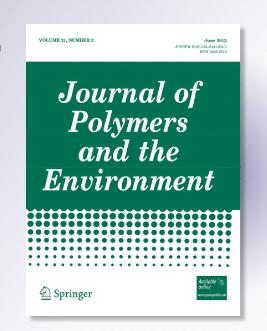聚乙醇酸改性聚乳酸共混物的物理性能及水解降解特性
摘要
本研究采用双螺杆挤出法制备了不同PGA含量的聚乳酸/聚乙醇酸(PLA/PGA)共混物,以PGA作为增强组分增强PLA的综合性能。考察了PGA含量对加工扭矩、力学性能、微观形貌、结晶性能、热变形抗力、气体阻隔性和水解降解行为的影响。变温扭矩、拉伸性能、弯曲性能、DMA等测试结果表明,刚性PGA组分对PLA材料有明显的增强作用。例如,与纯PLA相比,PLA/PGA(60/40)共混物的拉伸模量和拉伸强度增加了783.2 MPa(增加了22.4 MPa)%) and 11.1 MPa (an increase of 16.1%), respectively. The vicat softening temperature (VST) and thermal deformation tests show that PLA/PGA blends with higher PGA content, such as PLA with 40% PGA, exhibit significant improvement in thermal deformation resistance, with minimal deformation after 5 minutes in a \(100^{\,\circ }\)C oil bath. Moreover, the incorporation of 40 wt.% PGA significantly enhances the barrier properties of PLA, reducing water vapor permeability (WVP) by 74% and oxygen permeability (OPC) by 86% compared with pure PLA, clearly highlighting the substantial improvement in PLA’s gas barrier performance with PGA. In comparison to the relatively slow hydrolysis rate of PLA, the incorporation of PGA leads to a notable increase in the hydrolysis rate of PLA/PGA blends in alkaline solutions (pH = 13, 37\(\,^\circ\)C). At 40 wt.% PGA, the PLA/PGA blend’s hydrolysis rate rises from 0.13 wt.%/h to 1.55 wt.%/h, with a 94.9% weight loss after 60 hours of immersion. In summary, the incorporation of the PGA component significantly enhances the comprehensive performance of the PLA blend, potentially further expanding its application fields and scenarios.

In this study, poly(lactic acid)/poly(glycolic acid) (PLA/PGA) blends with varying PGA contents were prepared via twin-screw extrusion, in which PGA was used as reinforcing component to enhance the comprehensive performances of PLA. The influences of PGA content on processing torque, mechanical performances, microscopic morphology, crystallization property, thermal deformation resistance, gas barrier, and hydrolytic degradation behavior were investigated. The test results of variable temperature torque, tensile property, flexural property, and DMA, etc. show that the rigid PGA component has a significant reinforcing effect on the PLA materials. For instance, compared with pure PLA, the tensile modulus and tensile strength of the PLA/PGA (60/40) blend have increased by 783.2 MPa (an increase of 22.4%) and 11.1 MPa (an increase of 16.1%), respectively. The vicat softening temperature (VST) and thermal deformation tests show that PLA/PGA blends with higher PGA content, such as PLA with 40% PGA, exhibit significant improvement in thermal deformation resistance, with minimal deformation after 5 minutes in a \(100^{\,\circ }\)C oil bath. Moreover, the incorporation of 40 wt.% PGA significantly enhances the barrier properties of PLA, reducing water vapor permeability (WVP) by 74% and oxygen permeability (OPC) by 86% compared with pure PLA, clearly highlighting the substantial improvement in PLA’s gas barrier performance with PGA. In comparison to the relatively slow hydrolysis rate of PLA, the incorporation of PGA leads to a notable increase in the hydrolysis rate of PLA/PGA blends in alkaline solutions (pH = 13, 37\(\,^\circ\)C). At 40 wt.% PGA, the PLA/PGA blend’s hydrolysis rate rises from 0.13 wt.%/h to 1.55 wt.%/h, with a 94.9% weight loss after 60 hours of immersion. In summary, the incorporation of the PGA component significantly enhances the comprehensive performance of the PLA blend, potentially further expanding its application fields and scenarios.

 求助内容:
求助内容: 应助结果提醒方式:
应助结果提醒方式:


